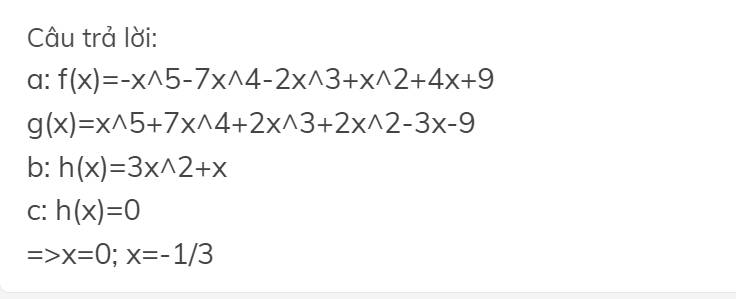Hãy nhập câu hỏi của bạn vào đây, nếu là tài khoản VIP, bạn sẽ được ưu tiên trả lời.

a: f(x)=-x^5-7x^4-2x^3+x^2+4x+9
g(x)=x^5+7x^4+2x^3+2x^2-3x-9
b: h(x)=3x^2+x
c: h(x)=0
=>x=0; x=-1/3

a, \(f\left(x\right)=9-3x^5+7x-2x^3+3x^5+x^2-3x-7x^4=-7x^4-2x^3+x^2+4x+9\)
\(g\left(x\right)=x^4+1+2x^2+7x^4+2x^3-3x-2x^2-x=8x^4+2x^3-4x+1\)
b, Ta có : \(h\left(x\right)=f\left(x\right)+g\left(x\right)=-7x^4-2x^3+x^2+4x+9+8x^4+2x^3-4x+1\)
\(=x^4+x^2+10\)
c, Ta có : \(x^4\ge0\forall x;x^2\ge0\forall x;10>0\Rightarrow x^4+x^2+10>0\)
Vậy phương trình ko có nghiệm ( đpcm )
Kết luận cuối là Vậy đa thức h(x) ko có nghiệm ( đpcm ) nhé

Lời giải:
a.
$A(x)=-x^5-7x^4-2x^3+x^2+4x+9$
$B(x)=x^5+7x^4+2x^3+2x^2-3x-9$
b.
$A(x)+B(x)=(-x^5-7x^4-2x^3+x^2+4x+9)+(x^5+7x^4+2x^3+2x^2-3x-9)$
$=(-x^5+x^5)+(-7x^4+7x^4)+(-2x^3+2x^3)+(x^2+2x^2)+(4x-3x)+(9-9)=3x^2+x$
$A(x)-B(x)=(-x^5-7x^4-2x^3+x^2+4x+9)-(x^5+7x^4+2x^3+2x^2-3x-9)$
$=(-x^5-x^5)+(-7x^4-7x^4)+(-2x^3-2x^3)+(x^2-2x^2)+(4x+3x)+(9+9)=-2x^5-14x^4-4x^3-x^2+7x+18$

a: \(A\left(x\right)=9-x^5+4x-2x^3+x^2-7x^4\)
\(=-x^5-7x^4-2x^3+x^2+4x+9\)
\(B\left(x\right)=x^5-9+2x^2+7x^4+2x^3-3x\)
\(=x^5+7x^4+2x^3+2x^2-3x-9\)
b: A(x)+B(x)
\(=-x^5-7x^4-2x^3+x^2+4x+9+x^5+7x^4+2x^3+2x^2-3x-9\)
\(=3x^2+x\)
A(x)-B(x)
\(=-x^5-7x^4-2x^3+x^2+4x+9-x^5-7x^4-2x^3-2x^2+3x+9\)
\(=-2x^5-14x^4-4x^3-x^2+7x+18\)

b)
Sửa đề: f(x)=A(x)+B(x)
Ta có: f(x)=A(x)+B(x)
\(=x^5+7x^4-9x^3-2x^2-\dfrac{1}{4}x-x^5+5x^4-2x^3+4x^2-\dfrac{1}{4}\)
\(=12x^4-11x^3+2x^2-\dfrac{1}{4}x-\dfrac{1}{4}\)
a) Ta có: \(A\left(x\right)=x^5-3x^2+7x^4-9x^3+x^2-\dfrac{1}{4}x\)
\(=x^5+7x^4-9x^3+\left(-3x^2+x^2\right)-\dfrac{1}{4}x\)
\(=x^5+7x^4-9x^3-2x^2-\dfrac{1}{4}x\)
Ta có: \(B\left(x\right)=5x^4-x^5+x^2-2x^3+3x^2-\dfrac{1}{4}\)
\(=-x^5+5x^4-2x^3+\left(x^2+3x^2\right)-\dfrac{1}{4}\)
\(=-x^5+5x^4-2x^3+4x^2-\dfrac{1}{4}\)


Cho 2 đa thức: f(x)= 9 - x5 + 4x - 2x3 + x2 - 7x4
g(x)= x5 - 9 + 2x2 + 7x4 + 2x3 - 3x
a) Sắp sếp các đa thức trên theo luỹ thừa giảm dần của biến
f(x)= 9 - x5 + 4x - 2x3 + x2 - 7x4
f(x) = -x5 - 7x4 - 2x3 + x2 + 4x + 9
g(x)= x5 - 9 + 2x2 + 7x4 + 2x3 - 3x
g(x) = x5 + 7x4 + 2x3 + 2x2 - 3x - 9
b) Tìm bậc, hệ số cao nhất, hệ số tự do của đa thức f(x); g(x)
f(x) = -x5 - 7x4 - 2x3 + x2 + 4x + 9
+ Bậc : 5 _ hệ số cao nhất : -1 _ hệ số tự do : 9
g(x) = x5 + 7x4 + 2x3 + 2x2 - 3x - 9
+ Bậc : 5_ hệ số cao nhất : 1 _ hệ số tự do : -9
c) Tính f(x) + g(x); f(x) - g(x)
f( x) + g(x) = ( -x5 - 7x4 - 2x3 + x2 + 4x + 9 ) +( x5 + 7x4 + 2x3 + 2x2 - 3x - 9 )
= -x5 - 7x4 - 2x3 + x2 + 4x + 9 + x5 + 7x4 + 2x3 + 2x2 - 3x - 9
= ( -x5 + x5 ) + ( -7x4 + 7x4 ) + ( -2x3 + 2x3 ) + ( x2 + 2x2 ) + ( 4x -3x ) + ( 9 - 9 )
= 3x2 + x
f( x) - g(x) = ( -x5 - 7x4 - 2x3 + x2 + 4x + 9 ) - ( x5 + 7x4 + 2x3 + 2x2 - 3x - 9 )
= -x5 - 7x4 - 2x3 + x2 + 4x + 9 - x5 - 7x4 - 2x3 - 2x2 + 3x + 9
= ( -x5 - x5 ) + ( -7x4 - 7x4 ) + ( -2x3 - 2x3 ) + ( x2 - 2x2 ) + ( 4x + 3x ) + ( 9 + 9 )
= -2x5 - 14x4 - 2x3 -x2 + 7x + 18